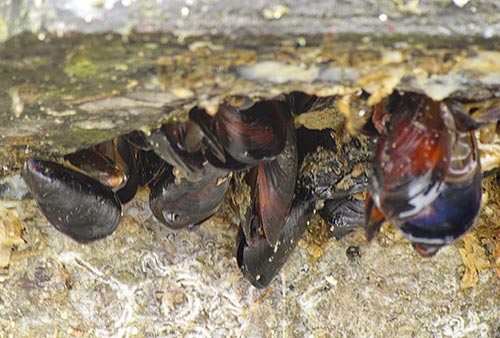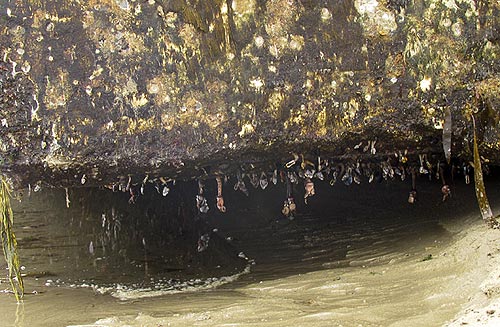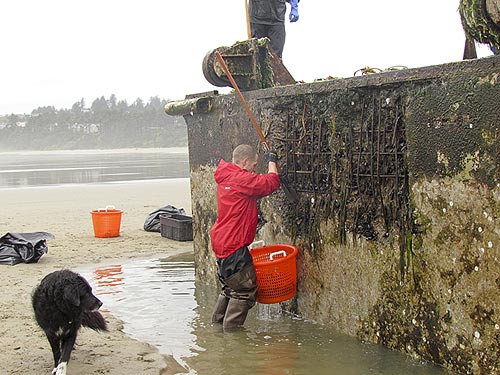 |
Oregon Coast Tsunami Debris Update on Possible Invasive Species
Published 03/25/2013

(Oregon Coast) – So far, most of the Oregon coast finds of presumed tsunami debris have been of moderate concern, according to ODFW biologist Steve Rumrill. He has been in charge of collecting samples from the boats found recently in Coos County, Lane County, Gleneden Beach and others, and then analyzing them. (Above: a recent Japanese boat found in Cannon Beach, photo courtesy Oregon State Parks)
Unlike the dock in Newport this summer, which had a whopping 130 different species and was classified as a high concern, the boats have had sea life clinging to them that have been fairly benign – at least scientists think so.

Barnacles on the dock at Newport this summer, photo Terry Morse
“The majority have been gooseneck barnacles, which are open ocean species,” Rumrill said.
Some have been a bit more ominous.
“There were some black and blue mussels, which we don't know what they are yet, and so they've been sent down to southern California to be confirmed by genetic testing,” Rumrill said.
Another species have been certain kinds of large pink acorn barnacles from Japan, which could threaten this ecosystem.

Ominous objects underneath the dock at Newport this summer - photo Terry Morse
Others are far, far smaller.
“There were some microscopic species that are still being identified by OSU scientists,” Rumrill said.
 |
| Detail of boat found in Coos County |
Rumrill believes roughly ten percent of the species found on these boats and other debris – presumed, but not yet confirmed to be from the Japanese tsunami – are problematic.
“About 90 percent have been gooseneck barnacles,” Rumrill said. “About seven percent have been mussels, and about three to four percent have been acorn barnacles.”
Meanwhile, other items have been popping up more and more. Rumrill noted there has been approximately one boat or major debris find a week since February, but now timbers are starting to show on Oregon coast beaches. Many of these are construction timbers and beams, clearly part of another structure. These, too, can have marine life clinging to them.
More ominously, however, have been a few found with a species called a ship worm, which burrows into wood. These, if they managed to get a foothold on the Oregon coast, could be a real problem at docks made of wood and other structures, perhaps even driftwood and near-coastal forests.

Detail of the marine life clinging to the boat at Gleneden Beach last month (photo State Parks)
So far, though, the tsunami dock from Newport last summer posed the biggest risk. Many of the creatures on their were scraped off the bottom of the object when it came ashore and dropped into the ocean.
Two of the species found it were actually on the list of some of the worst invasive species around the globe: a seaweed called wakame and the North Pacific Sea Star.
That dock had a lot of cement, which is porous, like rock, so marine life had an easier time clinging to it. Rumrill said many of these boats have been fiberglass, so they've been fairly clean.
What happens next? What do we look for along the beaches of the Oregon coast?
Rumrill said some agencies are starting to put together fact sheets of species to look for in tide pools and on the beach.
“We'll be depending on the public to be the eyes and ears,” Rumrill said. “The tide poolers, beach walkers. We don't have the personnel to go around and check the beaches. We'll rely on those just walking around the beach and looking into tide pools.”
It's a bit of a waiting game.
“Imagine the population of weeds in your yard,” Rumrill said. “They can exist at low levels for years, and then suddenly – bam. But hopefully we've nipped this in the bud.”

More About Oregon Coast hotels, lodging.....
More About Oregon Coast Restaurants, Dining.....
Scroll down to the bottom for constantly updated Tsunami Debris News.
 |
 |
LATEST Related Oregon Coast Articles
Oregon Coast, Valley and Likely Washington Coast to Get Some Aurora Borealis ... |
Back to Oregon Coast
Contact Advertise on BeachConnection.net
All Content, unless otherwise attributed, copyright BeachConnection.net Unauthorized use or publication is not permitted
Secrets of the Season |
Unusual Travel Articles TravelParanormal.com allows you to submit your own creepy tale or debunk one - or see up-to-the-minute news headlines about travel and the paranormal. News Headlines from All Over Oregon Need to scan Oregon headlines? Constantly updated news from all over Oregon: a comprehensive, up-to-the-minute display of news headlines from a variety of media |






































